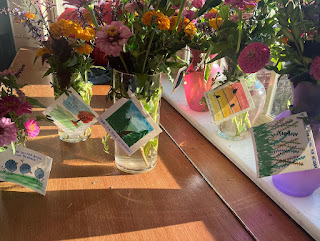Literature Review of Neighboring Books, Articles and Studies
The resources shared on this blog in the post named "Literature Review and Neighboring" provides a wide variety of books, articles, and studies that focus on the importance of building relationships with neighbors and creating a strong sense of community.
In today's fast-paced and often disconnected world, the idea of neighboring is crucial for creating a more caring and connected communities. I hope this literature review is helpful, although not exhaustive. My goal is to highlight some of my favorite resources in this field of study.
My first exposure to the subject of neighboring was the book, The Art of Neighboring by Dave Runyon and Jay Pathak. This book introduces the idea that neighboring doesn't have to be difficult. Instead, it can be about simple, everyday actions, such as greeting a neighbor, offering help, or just being available. The authors emphasize that many people feel disconnected or lonely in their neighborhoods, and by taking small steps, individuals can make a big difference. The main message of the book is that neighboring is not just for people who already have close relationships with their neighbors; it is for everyone. Building community through neighboring is an important part of making our world a kinder place.
Another resource listed in my review are the studies by Raj Chetty and his colleagues, which examines how the environment of a neighborhood can influence the future success of its residents. His studies found that where people live can have a big impact on their opportunities, especially for children. Chetty's research shows that when people live in neighborhoods with strong social networks and support, they tend to do better in school and are more likely to succeed in life. These studies highlight the importance of creating communities where people look out for one another and help each other grow. Strong neighborhoods provide not just emotional support, but also open up better chances for personal and professional success.
In addition to these books and studies, there are other works in my review that focuses on the personal side of neighboring.
For example, "Find Your People" by Jennie Allen talks about how to make deep, meaningful friendships. In today's world, many people feel isolated and struggle to connect with others on a deeper level. Allen's book offers practical advice on how to make and maintain close relationships with people, even in a busy world. She emphasizes the importance of being vulnerable, giving time to others, and investing in meaningful relationships. The book encourages readers to create connections that go beyond just being neighbors and into becoming close friends and support systems.
We Need to Hang Out by Billy Baker is another book mentioned on the webpage that highlights the importance of spending time with people and strengthening friendships. Baker focuses on the struggles many adults face in making time for friendships. He reflects on how people often get busy with work, family, and other commitments, which makes it harder to build close, lasting relationships. The book reminds readers that investing time in friendships is important and worth the effort.
There is also a more emotional and fictional take on neighboring found in Fredrik Backman's A Man Called Ove. This novel tells the story of a grumpy old man named Ove, who has trouble connecting with others but eventually forms strong bonds with his neighbors. Through Ove's journey, readers learn that even people who seem difficult or distant can benefit from the warmth of a supportive community. The story shows how small acts of kindness can change people's lives and help them feel less alone.
I do have some other favorites I will share those here, with links to reviews that I wrote on each book.
The Village Effect by Susan Pinkler.
The Simplest Way to Change the World by Dustin Willis.
Abundant Communities by John McKnight.
Together by Vivek Murthy.
Love Where You Live by Peter Kageyama.
Dedicated: The Case for Commitment in an Age of Infinite Browsing by Pete Davis.
This is Where You Belong by Melody Warnick.
The Hopeful Neighborhood Field Guide by Tony Cook and Don Everts.
The Vanishing Neighbor by Marc Dunkleman.
B.L.E.S.S.: 5 Everyday Ways to Love Your Neighbor and Change the World by Dave Ferguson
The Lonely Century: How to Restore Human Connection in a World that's Pulling Apart by Noreena Hertz.
In The Neighborhood: The Search for Community on an American Street, One Sleepover at a Time by Peter Lovenheim.
How to Love Your Neighbor Without Being Weird by Amy Lively
Placed for a Purpose: A Simple and Sustainable Vision for Loving Your Next-Door Neighbors by Chris and Elizabeth McKinney.
The Great Good Place: cafés, Coffee Shops, Bookstores, Bars, Hair Salons, and Other Hangouts at the Heart of a Community by Ray Oldenburg.
The Lonely American: Drifting Apart in the Twenty-First Century by Jacqueline Olds and Richard Schwartz.
Bowling Alone: The Collapse and Revival of American Community by Robert Putman.
In conclusion, the resources on the literature blog I keep updated provides a comprehensive look at the power of neighboring. Whether it's through practical advice, academic studies, or touching stories, these materials encourage us to think about how we can improve our relationships with the people around us. They remind us that neighboring is not just about knowing the people who live next door, but about building a community that supports one another. By practicing neighboring in our daily lives, we can create stronger, more connected neighborhoods that help everyone thrive.
MORE INFORMATION
Take the Engaged Neighbor pledge and become part of a movement! The pledge outlines five categories and 20 principles to guide you toward becoming an engaged neighbor. Sign the pledge at https://nomoregoodneighbors.com. Individuals who take the pledge do get special invitations to future events online and in person. Contact the blog author, David L. Burton via email at dburton541@yahoo.com or visit his website at http://engagedneighbor.com.





Comments
Post a Comment